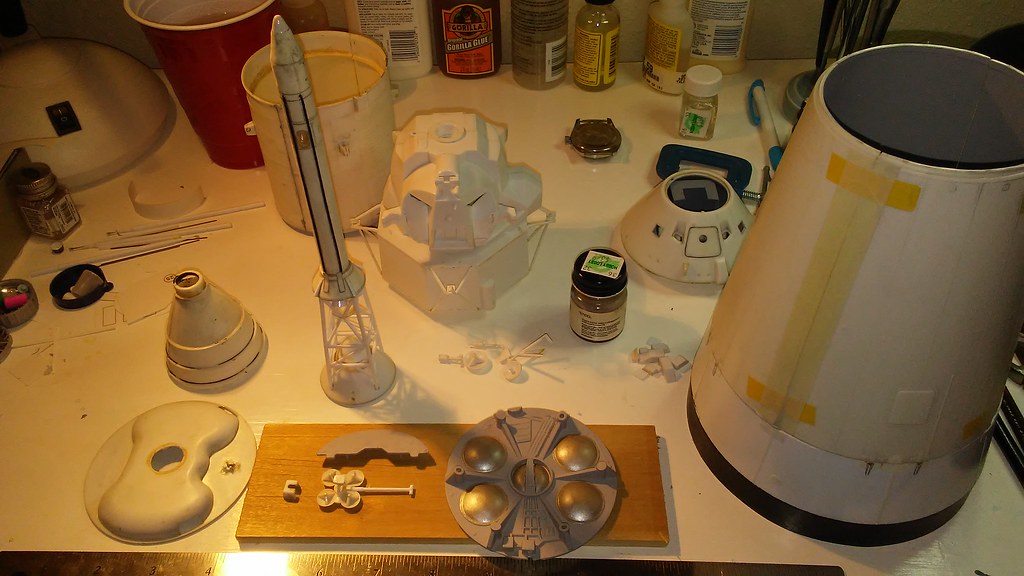- Member since
June 2012
- From: Anniston, AL
|
Posted by GAF
on Wednesday, January 16, 2019 9:32 PM
Bakster> Never let reality stand in the way of a good diorama!  Since there's a photo of a hose attached to the Bell X-1E, I say go ahead! Should be dramatic. Since there's a photo of a hose attached to the Bell X-1E, I say go ahead! Should be dramatic.
Gamera> Thanks! I actually touched up the paint on the D-7 today after some fill and sanding. After a few days to let the touch-up cure, I'll start masking for the second color coat. Weather permitting!
Ben> I forgot to mention your signature pic! Nice! You should grab a Group Build Badge to include with it (if you want). 
Project Report:

Some painting was done today on various items. The top of the Service Module was painted light grey and the tops of the tanks were painted "Steel". I'm at a quandry about what color to paint the tubing and conduit. Steel or yellow? Not sure, and there's not much info on a standard conbination. Images vary, or are not very clear. Decisions, decisions!
I've finished up the High-Gain Antenna for the Service Module and it is awaiting paint and connecting to the Service Module heat shield. I've also gloss coated the LES and the lower section of the LM Storage Area to help seal the paper parts. They are about ready for paint. Still trying to make decisions about the folding doors and whether to glue them together or not. Trying to think of various options.
Parts for the LM are ready to glue, and she's pretty much awaiting paint. Another decision to make about the areas to be painted black. The SM heat shield and engine nozzle are awaiting paint. If I have a streak of good, warm weather I might actually get some paint work done! Good luck with that in wintertime!
Meanwhile, I've found some nice image of the panels for the interior of the Command Module. Unfortunately, my color cartridge for the printer is out of ink, so I need to pick up a new one. The expense of that may delay printing the panels out, and decals. Still got a few months, however. If nothing else, I can always work on the base! 
Mission Director (GAF)
Today in Space History:
1946 January 16 - . Launch Site: White Sands. Launch Complex: White Sands. Launch Vehicle: V-2.
- V-2 flight tests in US initiated. - . Nation: Germany. Related Persons: von Braun.
-
U.S. upper atmosphere research program initiated with captured German V-2 rockets. A V-2 panel of representatives of various interested agencies was created, and a total of more than 60 V-2's were fired before the supply ran out. The Applied Physics Laboratory of Johns Hopkins University then undertook to develop a medium-altitude rocket, the Aerobee, while the Naval Research Laboratory (NRL) directed its efforts to the development of a large high-altitude rocket, first called the Neptune, later the Viking.
1969 January 16 - . 12:43 GMT - .
-
A day after the launch of Soyuz 5, Soyuz 4 docked with it. The Soyuz 4 active spacecraft was equipped with a long docking probe, designated 'Shtir'. The Soyuz 5 target spacecraft was equipped with the 'Konus' receptacle. The symbology lead Volynov to joke that he 'was being raped' when the hard docking was accomplished. Khrunov and Yeliseyev transferred to and returned in Soyuz 4, the feat they had hoped to accomplish in the cancelled Soyuz 2 flight almost two years earlier. The external crew transfer was also a test of the technique needed for the Soviet lunar landing.
1978 January 16 - .
- NASA Astronaut Training Group 8 selected. - . Nation: USA. Related Persons: Bluford, Brandenstein, Buchli, Coats, Covey, Creighton, Fabian, Fisher, Gardner, Gibson, Gregory, Griggs, Hart, Hauck, Hawley, Hoffman, Lucid, McBride, McNair, Mullane, Nagel, Nelson, Onizuka, Resnik, Ride, Scobee, Seddon, Shaw, Shriver, Stewart, Sullivan.
-
The group was selected to provide pilot, engineer, and scientist astronauts for space shuttle flights. Recruit women and minorities to introduce diversity into the astronaut corps. Qualifications: Pilots: Bachelor's degree in engineering, biological science, physical science or mathematics. Advanced degree desirable. At least 1,000 flight-hours of pilot-in-command time. Flight test experience desirable. Excellent health. Vision minimum 20/50 uncorrected, correctable to 20/20 vision; maximum sitting blood pressure 140/90. Height between 163 and 193 cm.
-
Mission Specialists: Bachelor's degree in engineering, biological science, physical science or mathematics and minimum three years of related experience or an advanced degree. Vision minimum 20/150 uncorrected, correctable to 20/20. Maximum sitting blood pressure of 140/90. Height between 150 and 193 cm.. 8,079 applicants, of which half met the basic qualifications. 208 invited for physical tests and interviews. Of the 35 selected, six were women, three were male African-Americans, and one was a male Asian-American.
- (NOTE: Mike Mullane of this group wrote a good autobiography of his time with the Shuttle program, "Riding Rockets". Good read. He states that the Columbia tragedy was not the only time the o-rings on the solid rocket boosters failed, and it was only sheer luck that more lives were not lost. It does make me wonder about their use on the new SLS for the Orion, even if they say they've worked the problems out. Famous last words.)

|